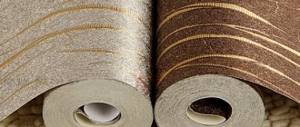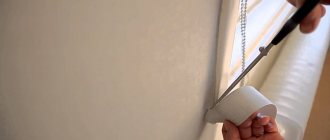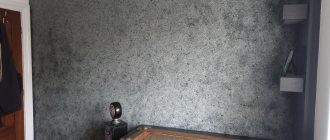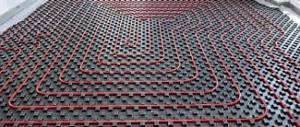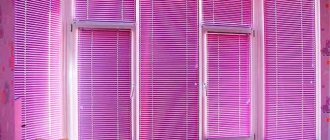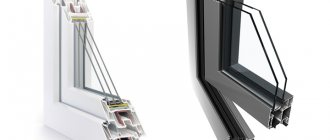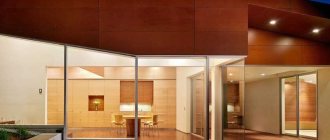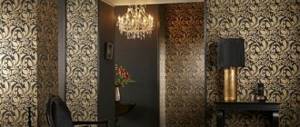Advantages and disadvantages of paper-based vinyl wallpaper
This wall covering, so beloved by many interior designers, has a number of very valuable features, such as:
- Ideal value for money;
- Hypoallergenic;
- Wide selection of textures and colors;
- Practicality and ease of gluing.
Another valuable advantage of this type of coating is that vinyl wallpaper is specially treated to prevent mold and harmful fungi.
However, vinyl wallpaper also has a significant drawback. This type of coating prevents the flow of air and, accordingly, disrupts the process of normal ventilation of the room. As a result, this wallpaper is undesirable for use in the bathroom, bedroom and children's room.
Technology for gluing vinyl wallpaper on paper
Even the highest quality and beautiful wallpaper can ruin the appearance of a room if it is not applied correctly. To avoid failures in this process, you should strictly adhere to the correct technology.
The wallpapering process consists of three stages: preparing the surface and wallpaper; stickers; final design stage.
Preparing the surface and wallpaper
Walls
Before gluing, the surface must be completely cleaned of remnants of previous wallpaper, leveled and cracks eliminated. The walls can be pre-primed and treated with a fungicidal agent to prevent the appearance of fungus. If the repair is secondary, then care should be taken to dismantle sockets and switches.
Also be sure to ensure that all air sources are isolated.
Wallpaper
- The wallpaper should be measured and cut, first added to the desired length of about 10 cm.
- To avoid confusion in the gluing sequence, the strips can be numbered.
- Then, spreading it on the floor, carefully coat it with glue along the entire length.
- And, after waiting for the stripes to swell a little, proceed to gluing.
It is important that the wallpaper strips swell approximately equally. This will help them stretch evenly and make the joints less noticeable.
Sticking
At the gluing stage, follow the following recommendations:
- It is better to start gluing the first strip from the corner;
- To avoid curvature of the gluing, it is better to use a level;
- Pay attention to the adjustment of joints;
- Avoid getting glue on the front surface of the wallpaper;
- Do not stretch the strip wide, as this may cause it to deform;
- After fixing the wallpaper on the wall, go over it with a roller or brush;
- The bottom edge of the wallpaper may extend slightly onto the baseboard.
Decor
After the wallpaper has dried, you need to trim off the excess and screw back the switches and sockets. If there are air bubbles left under the wallpaper, they can be easily removed with a syringe and then smoothed out with a roller or a special brush.
TOP 4 types of printing
Regular printing
Suitable for single-color printing or relatively simple designs in the form of shapes or patterns.
Conventional printing is one of the ways to apply a design.
Photo printing
High degree of detail, clear printing, rich, bright colors. Especially suitable for paintings, photographs.
Masterpiece painting in your home
Ultraviolet printing
An even brighter, slightly shiny image with a three-dimensional effect; the surface shimmers beautifully when exposed to sunlight. The coating is resistant to grease and moisture, and the print cannot be blurred. Ideal for kitchens, bathrooms, bathrooms.
Volumetric effect when exposed to sunlight
Stereoscopic printing
A new and most interesting type of printing with a 3D effect. The image can be single, occupying one wall or part of it, and panoramic. In addition, there are samples that glow in the dark, even LED ones.
A new and most interesting type of printing with 3D effect
Choose wallpaper with regular printing from the same batch, as the shades may differ and this will be noticeable. Rolls from the same batch have the same serial number.
Private options for gluing paper-based vinyl wallpaper
Meter wallpaper
The main advantage of such wallpaper is the minimum number of joints. However, many are scared by the unusual size, although the rules for gluing them are practically no different from standard wallpaper.
The most important thing is to correctly calculate the number of stripes. To do this, measure 1 meter in length on the wall and draw an even vertical line using a ruler and pencil. Then measure the height of the wall and add 5 - 10 cm to it. Divide the length of the roll (it is indicated on the package) by the result obtained.
This type of wallpaper should be glued in accordance with the previous instructions: cut the strips, apply glue using a roller, transfer the strip to the wall and smooth it with a roller or brush. The only caveat is that gluing should begin not from the corner, but from the drawn meter line.
Next, after complete drying and leveling, remove excess wallpaper with a spatula or sharp knife.
Ceiling wallpaper
Vinyl wallpaper is also well suited for ceiling decoration.
Basically, the rules for gluing the ceiling are similar to those given above. The only difficulty is the inconvenience of this process, since you have to keep your head up all the time.
To make the process easier, you can use the following recommendations:
- The ceiling surface should also be carefully prepared before gluing.
- To make the wallpaper stick better and not fall off, you can moisten the ceiling with water.
- A line should be drawn along the wall from which the gluing will begin.
- It is more convenient to glue the strips if the glue is applied not to the wallpaper, but to the ceiling.
- It is better to carry out this type of work together.
- Glue should be in the direction away from the window.
- If the ceiling is re-glued after pasting the walls, then their surface should be protected from glue. For these purposes, you can use newspapers or cling film.
What is non-woven fabric and why does it need vinyl wallpaper?
Vinyl wallpaper is available with one of two types of backing: paper and non-woven. The bottom layer is made from other materials, because its main task is to hold the wallpaper on the wall, and not at all for decorative properties.
Wallpaper on a non-woven backing, one meter wide
Non-woven fabric was invented not so long ago; it is made from cellulose and fabric fibers (non-woven fabric), therefore it has a number of advantages over paper:
- non-woven fabric is several times stronger than paper,
- non-woven fabric does not absorb glue, does not get wet and, as a result, does not stretch (very important when connecting joints),
- non-woven fabric adheres several times easier than paper to the wall; it sticks immediately and holds the canvas tightly.
In addition to wallpaper, non-woven backing is used in kitchen tablecloths and oilcloths for the table.
Classically, a non-woven backing is used on longer wallpaper, thereby making gluing many times easier, but slightly increasing the price. But paper-based vinyl wallpapers are cheaper, thereby ensuring constant demand for such wallpapers.
Of the disadvantages of vinyl, perhaps only one can be identified, the most basic. The vinyl structure does not allow air and steam to pass through well. This drawback does not allow gluing such wallpaper in children's rooms and rooms with poor air circulation.
Non-woven wallpaper from a popular Ukrainian manufacturer
Related article: Kitchen assembly instructions
Manufacturers are aware of this problem and have been trying to solve it for a long time. One such solution is to create micropores on the wallpaper to allow moisture and air to circulate between the wall and the room. Such wallpaper does not accumulate condensation on the wall and allows air to circulate quietly.
However, not everything is so smooth, because the free movement of air can harm the plaster coating of the wall, which is protected by the wallpaper, but that’s another conversation.
We would like to dispel another common misconception - vinyl wallpaper does not emit harmful substances and is not harmful to human health, at least this has not been proven by scientists, although the debate is still going on.
Glue selection
The quality of gluing directly depends on the glue chosen. Therefore, you should carefully consider purchasing it.
- The packaging should indicate that the adhesive is intended specifically for vinyl wallpaper.
- The advantage of vinyl adhesive is its sliding structure. The canvas coated with such glue can be easily re-glued if necessary.
- Non-woven adhesive is also suitable for gluing vinyl wallpaper, but it must first be made more liquid.
- Often, a wallpaper manufacturer also produces a corresponding type of adhesive. Therefore, if you are afraid of making a mistake in your choice, then purchase the glue recommended by the manufacturer.
- Remember, you shouldn’t skimp on glue. A low-quality product can leave stains, poorly fix the wallpaper and even change the color of the coating.
Fashion trends
Few people make renovations every year, succumbing to new fashion trends. Therefore, when choosing wallpaper, the key factors are its quality and combination with the chosen interior style.
However, it is still worth following modern fashion trends.
This is how bright, rich colors and original patterns come into fashion. But when choosing such wallpaper, the rest of the room’s interior should be made more calm. Conversely, the bright and unusual interior of the room will be well complemented by wallpaper in pastel colors.
You can choose a wallpaper pattern in accordance with the interior style: Scandinavian, English, oriental.
To zone the space, one of the walls of the room can be decorated with imitation wallpaper. On sale you can find options to imitate brickwork, wood and even fur.
Thus, by choosing vinyl wallpaper, you not only save time and effort, but also get an interesting, stylish interior.
Filontsev Viktor Nikolaevich
On the website: Author and editor of articles on the website pobetony.ru Education and work experience: Higher technical education. 12 years of experience in various industries and construction sites, 8 of which were abroad. Other skills and abilities: Has the 4th group of electrical safety clearance. Perform calculations using large data sets. Current employment: For the last 4 years he has been acting as an independent consultant for a number of construction companies.
Multifaceted vinyl and its production
Let's look at the most popular and well-known types of vinyl wallpaper, ranking them by quality.
Silkscreen printing
These vinyl wallpapers are the thinnest and lightest, smooth and pleasant to the touch. They are produced as follows: vinyl is applied to a paper backing with a thin film, to which fabric fibers or even small pieces of it are added, then this structure is pressed under high temperature with a press (hot stamping is performed).
Texture of silk-screen wallpaper
The result is a thin canvas with a very dense pattern embossed at a shallow depth. This wallpaper can be compared to a silk fabric, which is why this name was applied to it. Vinyl silk-screen printing has a wide range of colors, mainly floral themes.
Thick vinyl
This type of wallpaper includes imitation of various finishing materials, natural and artificial. Wallpaper can be made in the form of brick or tile, in the form of stone or plaster. They are slightly heavier in weight than silk-screen printing, although they look much more textured in relief and thickness, but they stick just as well.
Embossed Vinyl
The heaviest wallpaper using vinyl, with the thickest layer of this material. Such wallpapers have the greatest strength and the most obvious large texture. Their relief allows you to recreate the look of embossed rough leather, and the quality is close to anti-vandal.
Imitation of various materials, vinyl wallpaper feature
You can glue heavy vinyl of this type onto a less than ideal surface, since this wallpaper will hide everything. An excellent bonus for non-professional builders who find it difficult to bring the wall surface to perfection.
Embossed Vinyl
Chemically embossed vinyl is smooth, soft and washable. The wallpaper is medium in thickness, compared with those described above, and has a clear pattern on a glossy canvas. Highly durable and wear-resistant, they can be washed not only using cleaning tools, but also using some chemicals.
Silk-screen printing, as well as thick and embossed vinyl, are produced using the so-called hot stamping method. The already foamed vinyl layer, at high temperature, is pressed by two moving shafts, one presses the canvas to the other, and the latter presses the stencil.
Related article: Using cream curtains in the interior of rooms
In this case, the vinyl is compressed tightly, and at the same time the desired pattern is applied to its surface. The result is a relief texture, which is then painted in the desired color.
Cozy living room interior created with vinyl wallpaper
Embossed chemical vinyl is produced using inhibitors. Inhibitors block further foaming of the wallpaper, and also fix the applied pattern and relief, forming a protective decorative coating.
If you choose paper-based vinyl wallpaper, you can match it to any room, regardless of its purpose.
However, it is worth remembering that glossy wallpapers are best glued to perfectly leveled and prepared walls, while embossed wallpapers with matte images, on the contrary, hide small flaws and are suitable for walls of average quality.

